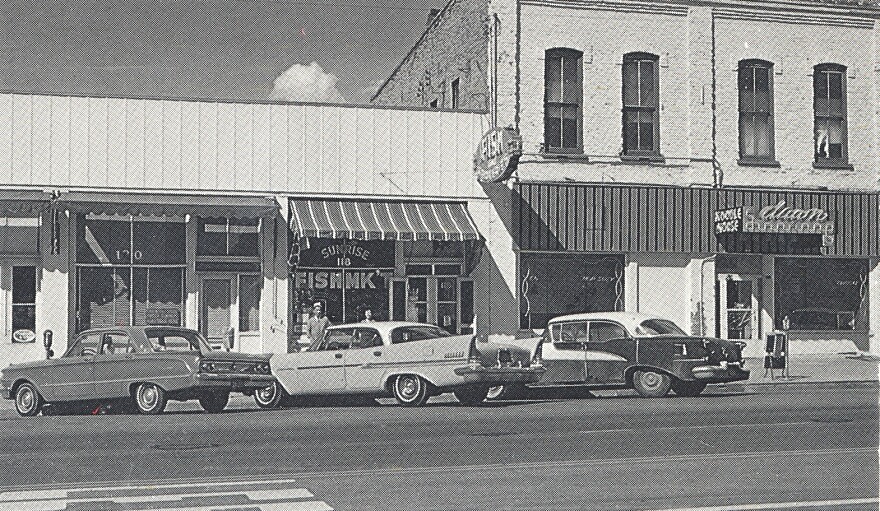Downtown Salt Lake City used to be home to a bustling and culturally rich Japantown neighborhood. But almost all of it was destroyed in the mid-60s in order to build the Salt Palace arena, which would later become the convention center it is today.


More than five decades later, members of the Japanese-American community have come together with the city to revitalize what’s left of it.
Craig Nagasawa’s family owned the Sunrise Fish Market in Japantown. The two blocks were his playground until he was 10 years old.
“Everybody knew each other,” Nagasawa said. “So we were just allowed to run around up and down the sidewalks, ride our tricycles, our bicycles.”
He and his friends would ride past mostly Japanese-owned businesses, like PeeWee’s gas station, Aloha Cafe and New Kimpa Cafe. Nagasawa said the neighborhood was a close-knit community.
“Everybody took care of us and watched out for us,” he said. “Whenever we were hungry, we’d just wander into whatever the nearest business was and they would feed us. So it was a spectacular and beautiful Japanese and Japanese-American way of growing up.”
Then 1966 came — and so did the wrecking balls to his playground.
“As a kid, I thought it was a great show,” Nagasawa said. “We would all go running to stand across the street and watch these huge wrecking balls take down the buildings. But I think for the adults, it was really harsh and hard for them because they're not only knowing they're leaving, but they're witnessing the actual physical destruction of what was going to happen.”
Everybody knew, Nagasawa said, this was going to be the end of the community.
“There was no central place for everybody to move to,” he said. “It was a kind of erasure of whatever Japanese-American community existed.”
Modern Day Japantown Street
All that’s left now is one block of 100 S called Japantown Street. The Salt Lake Buddhist Temple sits on the east end and the Japanese Church of Christ on the west.
Sen. Jani Iwamoto, D-Salt Lake City, attends the church and her mom plays the organ there as she’s done for years.
“It's just beautiful,” Iwamoto said while sitting in the chapel. “The architecture is old and it's over a hundred years old. The stained glass is original and then each of the pews were donated by families.”
Iwamoto is also a member of the Japanese Community Preservation Committee. She said the group organized in the early 2000s when the Salt Palace expanded on to the one remaining block of Japantown.
The preservation committee was able to put in a small garden as a buffer zone between the church and the convention center.
“So many people appreciate the past generation,” she said. “That was what the garden was supposed to be: to honor those pioneers.”
Still, the street faces the back end of the Salt Palace, where the loading docks regularly welcome big semi-trucks. There’s also a housing development that’s still under construction. It also has loading docks and a trash pickup area facing Japantown Street.
Iwamoto said her committee didn’t want the block to just become a series of the back ends of buildings.
“You kill streets that way,” she said.
She said they also worked with the developer to put some barriers around the trash and loading area to make it less visible from the street.
Revitalization Plans

On the other end of the block from the church sits the Salt Lake Buddhist Temple. On an early May afternoon, Rolen Yoshinaga stood outside in the sun, reflecting on his childhood visiting the original Japantown. He’s still involved in the community now, as a member of the temple’s Board of Directors.
“It's typical of 60s architecture,” Yoshinaga said about the temple, “Japanese themed awnings, light colored beige brick, lots of wood and some flowering cherry in the front.”
He said he’d like to see more of the street look like the Japantown he visited while growing up . To get there, the next step is a partnership with the Redevelopment Agency of Salt Lake City, which released draft designs in April.

Yoshinaga said the final vision of this project is a gathering place that honors Japanese culture.
The street would have wide sidewalks, benches and tables where people can gather, cherry blossom trees and japanese-style art and architecture.
“You might see different lights on the street, maybe even historical markers that might indicate where things were, maybe some artwork along the way,” he said. “There's more places for people to gather and to be around. And it's just something that looks much more like a Japantown street.”
One of the potential pieces of artwork is a large red sculpture of an origami bird at one of the street’s entrances.
But Yoshinaga said they’re limited in what they can do to revitalize the area since all the lots on the block are taken up by the Salt Palace, the apartment building under construction, the Japanese Church of Christ and the Salt Lake Buddhist Temple.
“We have to take this thing that we have here and create beauty with what we have,” he said. “Maybe this big loading dock isn't the most beautiful thing, but maybe we can create some beauty on the street that can exist in addition to [it].”
Yoshinaga said he knows Japantown can’t really be what it once was, but he’s excited that it can one day become more of a destination for the Japanese-American community to connect with each other. It can also be a place for other people to learn more about their culture and history.
“We have a diverse cultural heritage here in the valley,” he said. “But it's hidden. … People should know that we are a multicultural society here in Salt Lake and we've been a multicultural society here for over 100 hundred years.”


